The Radeon HD 4850 & 4870: AMD Wins at $199 and $299
by Anand Lal Shimpi & Derek Wilson on June 25, 2008 12:00 AM EST- Posted in
- GPUs
Building a RV770
We did this with NVIDIA's GT200 and it seemed to work out well, so let's start at the most basic level with AMD's RV770. Meet the Stream Processing Unit:
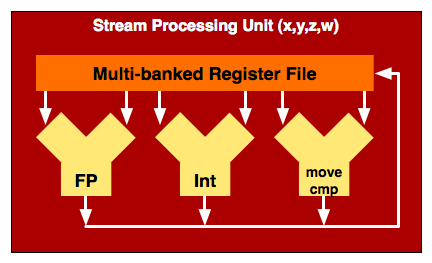
AMD's Stream Processing Unit is very similar to NVIDIA's SP in G80/G92/GT200, so similar in fact that I drew them the same way. Keep in mind that the actual inner workings of one of these units is far more complex than three ALUs but to keep things simple and consistent that's how I drew it (the actual hardware is a fused FP MUL + ADD unit, for those who care). AMD has four of these stream processing units in a processor block and they are called x, y, z or w units.
There's a fifth unit called a t-unit (the t stands for transcendental, meaning the type of operations it is capable of processing):

The t-unit can do everything a x,y,z or w-unit can do, but it also can do transcendental operations (represented by the SFU block in the diagram above). NVIDIA has the same functionality, it simply chooses to expose it in a different way (which we'll get to shortly). AMD considers each one of these units (x,y,z,w and t) a processing unit, and the RV770 has 800 of them (the RV670 had 320).
AMD pairs four of these stream processing units (x,y,z and w) with a t-unit and puts them together as a block, which I have decided to call a Streaming Processor (SP):

The area in red is actually the SP, but unlike one of NVIDIA's SPs, one of AMD's can handle up to five instructions at the same time. The only restriction here is that all five units have to be working on the same thread.
AMD then groups 16 of these SPs into something they like to call a SIMD core (AMD has less confusing, but far worse names for its architectural elements than NVIDIA):
|
AMD's SIMD Core
|
NVIDIA's SM
|
 |
 |
A SIMD core is very similar to NVIDIA's SM with a couple of exceptions:
1) There are more SPs in AMD's SIMD Core (16 vs 8)
2) The SPs are wider and can process, at peak, 5x the number of instructions as NVIDIA's SPs
3) The Instruction and Constant caches are not included in the SIMD core, AMD places them further up the ladder.
4) AMD pairs its texture units and texture cache with its SPs at the SIMD core level, while NVIDIA does it further up the ladder.
5) See the two SFUs in NVIDIA's SM? While NVIDIA has two very fast Special Function Units in its SM, AMD equips each SP with its own SFU. It's unclear which approach is actually faster given that we don't know the instruction latency or throughput of either SFU.
Note that at this point, the RV770 is really no different than the RV670 (the GPU used in the Radeon HD 3870). The next step is where AMD and NVIDIA really diverge; while NVIDIA's GT200 takes three SMs and groups them into a Texture/Processing Cluster (TPC) and then arranging 10 TPCs on its chip, AMD simply combines 10 SIMD cores:
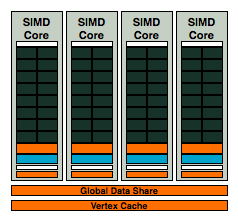
AMD's RV670
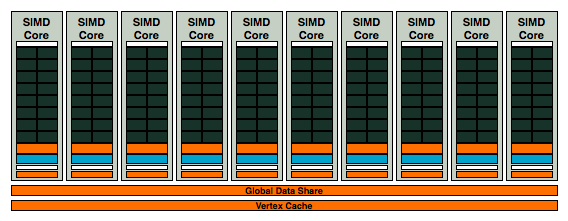
10 SIMD cores at your disposal in AMD's RV770, this is how AMD goes from competitive, to downright threatening
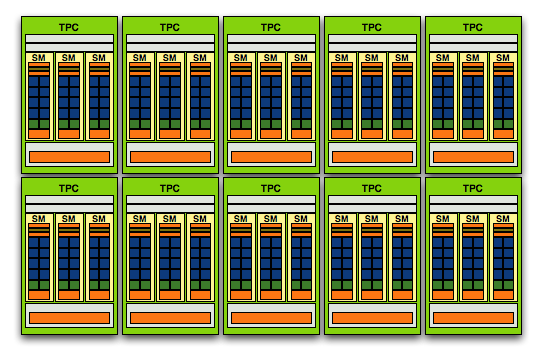
NVIDIA's GT200 Streaming Processor Array (SPA), it has fewer execution resources but more encapsulation around them, the focus here is on thread management
With 10 SIMD cores the RV770, it has 2.5x the number of execution units as a RV670. It even has more theoretical processing power than NVIDIA's GT200. If you just look at the number of concurrent instructions that can be processed on RV770 vs. GT200, the RV770's 800 execution units to GT200's 240 (+ 60 SFUs) is in a completely different league.
| NVIDIA GT200 | AMD RV770 | AMD RV670 | |
| SP Issue Width | 1-way | 5-way | 5-way |
| # of SPs | 240 | 160 | 64 |
| Worst Case Dependent Instruction Throughput | 240 | 160 | 64 |
| Maximum Scalar Instruction Throughput | 480* | 800 | 320 |
We'll be talking about efficiency and resource utilization in the coming pages, but immediately you'll notice that the RV770 (like the RV670 and R600 that came before it) has the potential to be slower than NVIDIA's architectures or significantly faster, depending entirely on how instruction or thread heavy the workload is. NVIDIA's architecture prefers tons of simple threads (one thread per SP) while AMD's architecture wants instruction heavy threads (since it can work on five instructions from a single thread at once).
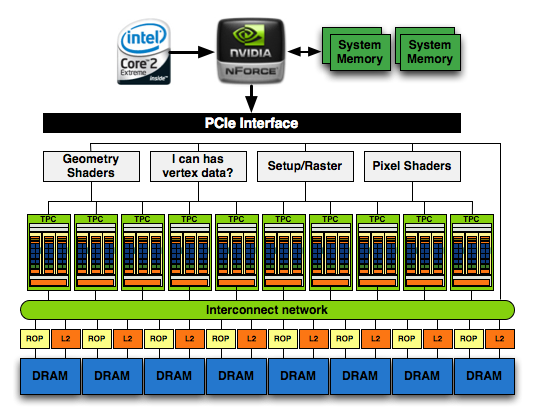
NVIDIA's GeForce GTX 280
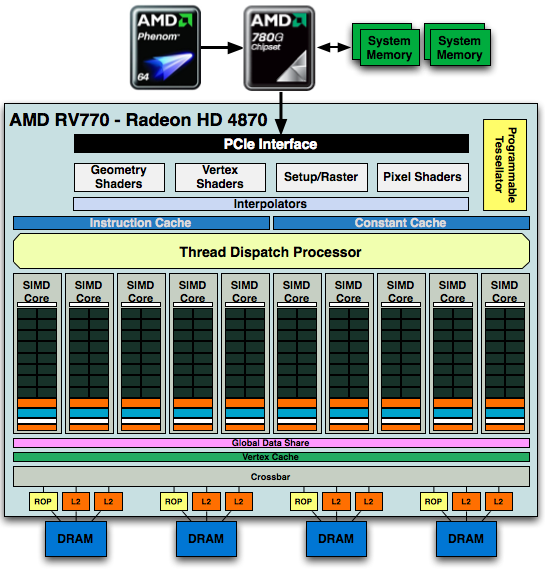
AMD's Radeon HD 4870
The full GPU is pretty impressive:
1) See the Instruction and Constant Caches up top? NVIDIA includes them in each SM while AMD seems to include them outside of the SIMD core clusters.
2) The RV770 only has four 64-bit memory controllers compared to the eight in GT200
3) The Programmable Tessellator is left over from the Xbox 360's GPU (and R600/RV670), unfortunately it is unused by most developers as there is no DirectX support for it yet.
4) AMD has dedicated hardware attribute interpolators, something NVIDIA's hardware shares with its special function units (SFUs).
Other than the differences we mentioned above, AMD's architecture is similar in vain to NVIDIA's, there are just a handful of design choices that set the two apart. Just like NVIDIA took its G80/G92 architecture and made it larger, AMD did the same with RV770 - it took RV670 and more than doubled its execution resources.
AMD took a bigger leap with RV770 from RV670 than NVIDIA did from G80/G92 to GT200, but it makes sense given that AMD had to be more competitive than it even was in the last generation.










215 Comments
View All Comments
paydirt - Wednesday, June 25, 2008 - link
This is a review site. This isn't a site to market/promote products.formulav8 - Thursday, June 26, 2008 - link
They do recommend hardware for different price points and such. So they do market in a way. Have you seen anands picks links? That is promoting products and does it through his referral links as well to get paid to do so. :)Anyways, mentioning something as a better buy up to a certain price point would be helpful to someone who is not really in the know.
Jason
shadowteam - Wednesday, June 25, 2008 - link
You've got excellent written skills buddy, and I can't help thinking you're actually better at reviews than your m8 (no offence Anand), but what I truly meant from my post above is what you summed up rather well in your conclusive lines, quote: "You can either look at it as AMD giving you a bargain or NVIDIA charging too much, either way it's healthy competition in the graphics industry once again (after far too long of a hiatus)"Either way? Why should anyone look the other way? NV is clearly shitting all over the place, and you can tell that from the email they send you (or Anand) a couple days back. So they ripped us off for 6 months, and now suddenly decide the 9800GTX is worth $200?
Healthy competition? Could you please elaborate on this further?
$199 4850 vs $399 GTX260.... yup! that's healthy
GTX+ vs 4850?
Does that mean the GTX260 is now completely irrelevant? In fact, the 2xx series is utterly pointless no matter how you look at it.
To bash on AMD, the 4870 is obviously priced high. For $100 extra, all you get is an OC'ed 4850 w/ DDR5 support. I don't think anyone here cares about DDR5, all that matters is performance, and the extra bucks plainly not worth it. From a consumers' perspective, the 4850 is the best buy, the 4870 isn't.
mlambert890 - Sunday, July 13, 2008 - link
"200 series is utterly pointless"Yep... pointless unless you want the fastest card (280), then it has a point.
Pointless to YOU possibly because you're focusing on perf per dollar. Good for you. Nice of you to presume to force that view on the world.
Absolute performance? GTX 280 seems near the top of every benchmark there bud. Both in single card and in SLI where, last I checked, it gives up maybe TWO instances to the 4870CF - Bioshock and CoD and in both cases framerates are north of 100 at 2560. The 4870, on the other hand, falls WELL short of playable at that res in CF in most other benches.
High res + high perf = 200 series. Sorry if thats offensive to the egos of those who cant afford the cards.
Theres a lot in life we can and cant afford. Should have ZERO impact on ABSOLUTE PERFORMANCE discussions.
FITCamaro - Wednesday, June 25, 2008 - link
AMD/ATI has to make some money somewhere. And regardless, at $300, the 4870 is a hell of a deal compared to the competition. Yes the 4850 is probably the best value. But the 4870 is still right behind it if you want a decent amount of extra performance at a great price.Nvidia may have the fastest thing out there. But only the richest, most brain dead idiots who have not a care in the world about how they spend their (or their parents) money will buy it with cards like the 4850 and 4870 available.
And its pretty sad when your new $650 high end card is routinely beat by two of your last generation cards (8800GT) that you can get for $150 each or less. It wouldn't be as big a deal if the new card was $300-350 but at $650, it should be stomping on it.
I think Nvidia is in for a reality check for what people want. If their new chips are only going to cater to the top 1% of the market, they're going to find themselves quickly in trouble. Especially with the all the issues their chipsets have for 6 months after release. And their shoddy drivers. I mean this past Friday I decided to try and set up some profiles so that when I started up Age of Conan, it would apply an overclock to my GPU and unapply it after I exited, it ended up locking up my PC continuously. I had to restore my OS from a backup disc because not even completely uninstalling and reinstalling my nvidia chipset and video drivers fixed it. And in my anger, I didn't back up my "My Documents" folder so I lost 5 years worth of stuff, largely pictures.
mlambert890 - Sunday, July 13, 2008 - link
"Nvidia may have the fastest thing out there. But only the richest, most brain dead idiots who have not a care in the world about how they spend their (or their parents) money will buy it with cards like the 4850 and 4870 available."You just summed it up in that first sentence there bud. NVidia has the fastest thing out there. The rest is just opinion, bitterness and noise.
I notice that the tone of the "enthusiast" community seems to be laser focused on cost now. This is like car discussions. People want to pretend to be "Xtreme" but what they really want to see is validation of whatever it is THEY can afford.
Have fun with the 4870 by all means, its a great card. But the GTX280 IS faster. Did NVidia price it too high? Dont know and dont care.
These are PERFORMANCE forums to all of the people that dont get that. Maybe even the editors need to be reminded.
If I want to see an obsession with "bang for the buck" Ill go to Consumer Reports.
I mean seriously. How much of a loser are you when you're taking a shot like "your PARENTS money"? LOL...
Personally, I treat the PC hobby as an expensive distraction. Ive been a technology pro for 15 years now and this is my vice. As an adult earning my own money, I can decide how I spend it and the difference between $500 and a grand isnt a big deal.
The rehtoric on forums is really funny. People throw the "kid/parents" insult around alot, but I think its more likely that the people who take prices beyond what they can afford as some kind of personal insult are more likely the kids here.
formulav8 - Thursday, June 26, 2008 - link
"Nvidia may have the fastest thing out there. But only the richest, most brain dead idiots who have not a care in the world about how they spend their (or their parents) money will buy it with cards like the 4850 and 4870 available."Yuk Yuk Yuk :)
Jason
drpepper128 - Wednesday, June 25, 2008 - link
To be honest, while I was reading the article I felt as if the article seemed a little ATI biased, but I guess that goes to show you that two different people can get drastically different opinions from the same article.The real reason I’m posting this is I want to thank you guys for writing some of the best articles that Anandtech has ever written. I read every page and enjoyed the whole thing. Keep up the great work guys and I look forward to reading more (especially about Nehalem and anything relating to AMD’s future architecture).
Also, is GDDR5 coming to the 4850 ever? If so, maybe it would be a drastically better buy.
Thank you,
drpepper128
Clauzii - Wednesday, June 25, 2008 - link
Damn, You R pissed!! :OOK, get some sleep and wake up smiling tomorrow, knowing that It's ATI needing to raise prices - - - and go get that 4870 :))
Clauzii - Wednesday, June 25, 2008 - link
OH, " ... that It's NOT ATI needing to ... "BTW: I actually read the review as pretty neutral, making a hint here and there that the further potential of the HD4870 is quite big :)